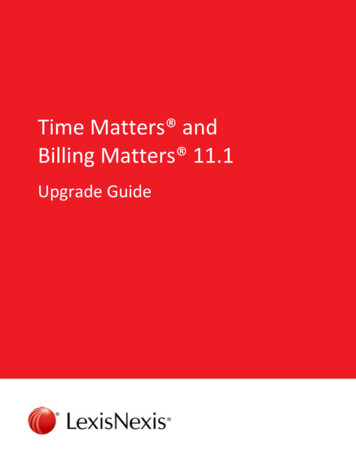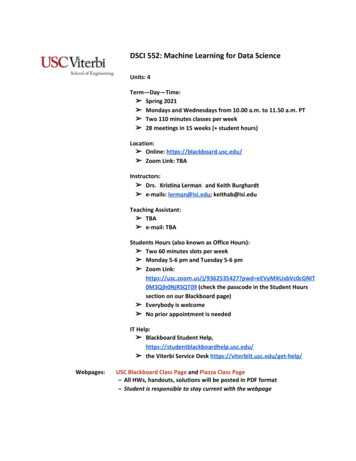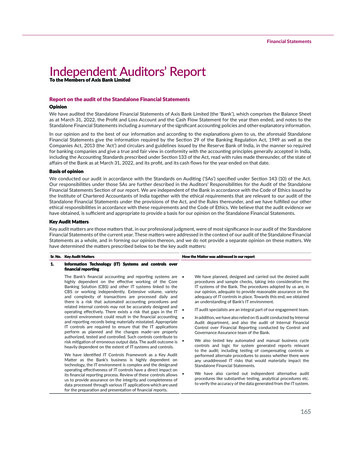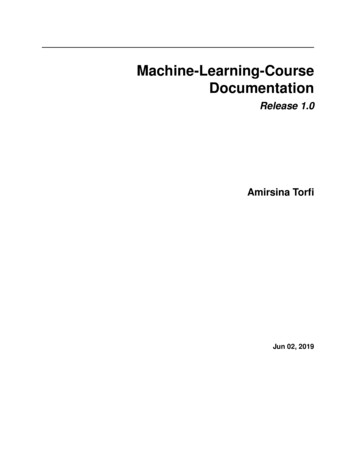
Transcription
Machine Learning that MattersKiri L. Wagstaffkiri.l.wagstaff@jpl.nasa.govJet Propulsion Laboratory, California Institute of Technology, 4800 Oak Grove Drive, Pasadena, CA 91109 USAAbstractMuch of current machine learning (ML) research has lost its connection to problems ofimport to the larger world of science and society. From this perspective, there exist glaring limitations in the data sets we investigate, the metrics we employ for evaluation,and the degree to which results are communicated back to their originating domains.What changes are needed to how we conduct research to increase the impact that MLhas? We present six Impact Challenges to explicitly focus the field’s energy and attention,and we discuss existing obstacles that mustbe addressed. We aim to inspire ongoing discussion and focus on ML that matters.1. IntroductionAt one time or another, we all encounter a friend,spouse, parent, child, or concerned citizen who, uponlearning that we work in machine learning, wonders“What’s it good for?” The question may be phrasedmore subtly or elegantly, but no matter its form, it getsat the motivational underpinnings of the work that wedo. Why do we invest years of our professional livesin machine learning research? What difference does itmake, to ourselves and to the world at large?Much of machine learning (ML) research is inspiredby weighty problems from biology, medicine, finance,astronomy, etc. The growing area of computationalsustainability (Gomes, 2009) seeks to connect ML advances to real-world challenges in the environment,economy, and society. The CALO (Cognitive Assistantthat Learns and Organizes) project aimed to integratelearning and reasoning into a desktop assistant, potentially impacting everyone who uses a computer (SRIInternational, 2003–2009). Machine learning has effecAppearing in Proceedings of the 29 th International Conference on Machine Learning, Edinburgh, Scotland, UK, 2012.Copyright 2012 California Institute of Technology.tively solved spam email detection (Zdziarski, 2005)and machine translation (Koehn et al., 2003), twoproblems of global import. And so on.And yet we still observe a proliferation of publishedML papers that evaluate new algorithms on a handfulof isolated benchmark data sets. Their “real world”experiments may operate on data that originated inthe real world, but the results are rarely communicatedback to the origin. Quantitative improvements in performance are rarely accompanied by an assessment ofwhether those gains matter to the world outside ofmachine learning research.This phenomenon occurs because there is nowidespread emphasis, in the training of graduate student researchers or in the review process for submittedpapers, on connecting ML advances back to the largerworld. Even the rich assortment of applications-drivenML research often fails to take the final step to translate results into impact.Many machine learning problems are phrased in termsof an objective function to be optimized. It is time forus to ask a question of larger scope: what is the field’sobjective function? Do we seek to maximize performance on isolated data sets? Or can we characterizeprogress in a more meaningful way that measures theconcrete impact of machine learning innovations?This short position paper argues for a change in howwe view the relationship between machine learning andscience (and the rest of society). This paper does notcontain any algorithms, theorems, experiments, or results. Instead it seeks to stimulate creative thoughtand research into a large but relatively unaddressed issue that underlies much of the machine learning field.The contributions of this work are 1) the clear identification and description of a fundamental problem: thefrequent lack of connection between machine learningresearch and the larger world of scientific inquiry andhumanity, 2) suggested first steps towards addressingthis gap, 3) the issuance of relevant Impact Challengesto the machine learning community, and 4) the identification of several key obstacles to machine learning
Machine Learning that Mattersimpact, as an aid for focusing future research efforts.Whether or not the reader agrees with all statementsin this paper, if it inspires thought and discussion, thenits purpose has been achieved.2. Machine Learning for MachineLearning’s SakeThis section highlights aspects of the way ML researchis conducted today that limit its impact on the largerworld. Our goal is not to point fingers or critique individuals, but instead to initiate a critical self-inspectionand constructive, creative changes. These problems donot trouble all ML work, but they are common enoughto merit our effort in eliminating them.The argument here is also not about “theory versusapplications.” Theoretical work can be as inspired byreal problems as applied work can. The criticisms herefocus instead on the limitations of work that lies between theory and meaningful applications: algorithmic advances accompanied by empirical studies thatare divorced from true impact.2.1. Hyper-Focus on Benchmark Data SetsIncreasingly, ML papers that describe a new algorithmfollow a standard evaluation template. After presenting results on synthetic data sets to illustrate certainaspects of the algorithm’s behavior, the paper reportsresults on a collection of standard data sets, such asthose available in the UCI archive (Frank & Asuncion,2010). A survey of the 152 non-cross-conference papers published at ICML 2011 7%)(23%)(1%)include experiments of some sortuse synthetic datause UCI datause ONLY UCI and/or synthetic datainterpret results in domain contextThe possible advantages of using familiar data sets include 1) enabling direct empirical comparisons withother methods and 2) greater ease of interpretingthe results since (presumably) the data set propertieshave been widely studied and understood. However,in practice direct comparisons fail because we haveno standard for reproducibility. Experiments vary inmethodology (train/test splits, evaluation metrics, parameter settings), implementations, or reporting. Interpretations are almost never made. Why is this?First, meaningful interpretations are hard. Virtuallynone of the ML researchers who work with these datasets happen to also be experts in the relevant scientificdisciplines. Second, and more insidiously, the ML fieldneither motivates nor requires such interpretation. Re-viewers do not inquire as to which classes were wellclassified and which were not, what the common error types were, or even why the particular data setswere chosen. There is no expectation that the authors report whether an observed x% improvement inperformance promises any real impact for the originaldomain. Even when the authors have forged a collaboration with qualified experts, little paper space isdevoted to interpretation, because we (as a field) donot require it.The UCI archive has had a tremendous impact on thefield of machine learning. Legions of researchers havechased after the best iris or mushroom classifier. Yetthis flurry of effort does not seem to have had any impact on the fields of botany or mycology. Do scientistsin these disciplines even need such a classifier? Dothey publish about this subject in their journals?There is not even agreement in the community aboutwhat role the UCI data sets serve (benchmark? “realworld”?). They are of less utility than synthetic data,since we did not control the process that generatedthem, and yet they fail to serve as real world datadue to their disassociation from any real world context (experts, users, operational systems, etc.). It isas if we have forgotten, or chosen to ignore, that eachdata set is more than just a matrix of numbers. Further, the existence of the UCI archive has tended toover-emphasize research effort on classification and regression problems, at the expense of other ML problems (Langley, 2011). Informal discussions with otherresearchers suggest that it has also de-emphasized theneed to learn how to formulate problems and define features, leaving young researchers unprepared totackle new problems.This trend has been going on for at least 20 years.Jaime Carbonell, then editor of Machine Learning,wrote in 1992 that “the standard Irvine data sets areused to determine percent accuracy of concept classification, without regard to performance on a largerexternal task” (Carbonell, 1992). Can we change thattrend for the next 20 years? Do we want to?2.2. Hyper-Focus on Abstract MetricsThere are also problems with how we measure performance. Most often, an abstract evaluation metric(classification accuracy, root of the mean squared error or RMSE, F-measure (van Rijsbergen, 1979), etc.)is used. These metrics are abstract in that they explicitly ignore or remove problem-specific details, usually so that numbers can be compared across domains.Does this seemingly obvious strategy provide us withuseful information?
Machine Learning that MattersPhrase problemas a machinelearning taskChoose or developalgorithmInterpretresultsCollectdataSelect orgeneratefeaturesChoose metrics,conduct experimentsPublicize results torelevant user communityNecessarypreparationThe "machinelearning contribution"Persuade users toadopt techniqueImpactFigure 1. Three stages of a machine learning research program. Current publishing incentives are highly biased towardsthe middle row only.It is recognized that the performance obtained bytraining a model M on data set X may not reflect M’sperformance on other data sets drawn from the sameproblem, i.e., training loss is an underestimate of testloss (Hastie et al., 2001). Strategies such as splittingX into training and test sets or cross-validation aimto estimate the expected performance of M0 , trainedon all of X, when applied to future data X 0 .However, these metrics tell us nothing about the impact of different performance. For example, 80% accuracy on iris classification might be sufficient for thebotany world, but to classify as poisonous or ediblea mushroom you intend to ingest, perhaps 99% (orhigher) accuracy is required. The assumption of crossdomain comparability is a mirage created by the application of metrics that have the same range, but not thesame meaning. Suites of experiments are often summarized by the average accuracy across all data sets.This tells us nothing at all useful about generalizationor impact, since the meaning of an x% improvementmay be very different for different data sets. A relatedproblem is the persistence of “bake-offs” or “mindless comparisons among the performance of algorithmsthat reveal little about the sources of power or the effects of domain characteristics” (Langley, 2011).Receiver Operating Characteristic (ROC) curves areused to describe a system’s behavior for a range ofthreshold settings, but they are rarely accompaniedby a discussion of which performance regimes are relevant to the domain. The common practice of reportingthe area under the curve (AUC) (Hanley & McNeil,1982) has several drawbacks, including summarizingperformance over all possible regimes even if they areunlikely ever to be used (e.g., extremely high false positive rates), and weighting false positives and false negatives equally, which may be inappropriate for a givenproblem domain (Lobo et al., 2008). As such, it is insufficiently grounded to meaningfully measure impact.Methods from statistics such as the t-test (Student,1908) are commonly used to support a conclusionabout whether a given performance improvement is“significant” or not. Statistical significance is a function of a set of numbers; it does not compute real-worldsignificance. Of course we all know this, but it rarelyinspires the addition of a separate measure of (true)significance. How often, instead, a t-test result servesas the final punctuation to an experimental utterance!2.3. Lack of Follow-ThroughIt is easy to sit in your office and run a Weka (Hallet al., 2009) algorithm on a data set you downloadedfrom the web. It is very hard to identify a problemfor which machine learning may offer a solution, determine what data should be collected, select or extract relevant features, choose an appropriate learningmethod, select an evaluation method, interpret the results, involve domain experts, publicize the results tothe relevant scientific community, persuade users toadopt the technique, and (only then) to truly havemade a difference (see Figure 1). An ML researchermight well feel fatigued or daunted just contemplatingthis list of activities. However, each one is a necessarycomponent of any research program that seeks to havea real impact on the world outside of machine learning.Our field imposes an additional obstacle to impact.Generally speaking, only the activities in the middlerow of Figure 1 are considered “publishable” in the MLcommunity. The Innovative Applications of ArtificialIntelligence conference and International Conferenceon Machine Learning and Applications are exceptions.The International Conference on Machine Learning(ICML) experimented with an (unreviewed) “invitedapplications” track in 2010. Yet to be accepted as amainstream paper at ICML or Machine Learning orthe Journal of Machine Learning Research, authorsmust demonstrate a “machine learning contribution”that is often narrowly interpreted by reviewers as “the
Machine Learning that Mattersdevelopment of a new algorithm or the explication of anovel theoretical analysis.” While these are excellent,laudable advances, unless there is an equal expectationfor the bottom row of Figure 1, there is little incentiveto connect these advances with the outer world.Reconnecting active research to relevant real-worldproblems is part of the process of maturing as a research field. To the rest of the world, these are theonly visible advances of ML, its only contributions tothe larger realm of science and human endeavors.3. Making Machine Learning MatterRather than following the letter of machine learning,can we reignite its spirit? This is not simply a matterof reporting on isolated applications. What is neededis a fundamental change in how we formulate, attack,and evaluate machine learning research projects.3.1. Meaningful Evaluation MethodsThe first step is to define or select evaluation methods that enable direct measurement, wherever possible, of the impact of ML innovations. In addition totraditional measures of performance, we can measuredollars saved, lives preserved, time conserved, effortreduced, quality of living increased, and so on. Focusing our metrics on impact will help motivate upstreamrestructuring of research efforts. They will guide howwe select data sets, structure experiments, and defineobjective functions. At a minimum, publications canreport how a given improvement in accuracy translatesto impact for the originating problem domain.The reader may wonder how this can be accomplished,if our goal is to develop general methods that apply across domains. Yet (as noted earlier) the common approach of using the same metric for all domains relies on an unstated, and usually unfounded,assumption that it is possible to equate an x% improvement in one domain with that in another. Instead, if the same method can yield profit improvements of 10,000 per year for an auto-tire business aswell as the avoidance of 300 unnecessary surgical interventions per year, then it will have demonstrated apowerful, wide-ranging utility.3.2. Involvement of the World Outside MLMany ML investigations involve domain experts as collaborators who help define the ML problem and labeldata for classification or regression tasks. They canalso provide the missing link between an ML performance plot and its significance to the problem domain.This can help reduce the number of cases where an MLsystem perfectly solves a sub-problem of little interestto the relevant scientific community, or where the MLsystem’s performance appears good numerically but isinsufficiently reliable to ever be adopted.We could also solicit short “Comment” papers, to accompany the publication of a new ML advance, thatare authored by researchers with relevant domain expertise but who were uninvolved with the ML research.They could provide an independent assessment of theperformance, utility, and impact of the work. Asan additional benefit, this informs new communitiesabout how, and how well, ML methods work. Raising awareness, interest, and buy-in from ecologists,astronomers, legal experts, doctors, etc., can lead togreater opportunities for machine learning impact.3.3. Eyes on the PrizeFinally, we should consider potential impact when selecting which research problems to tackle, not merelyhow interesting or challenging they are from the MLperspective. How many people, species, countries, orsquare meters would be impacted by a solution to theproblem? What level of performance would constitutea meaningful improvement over the status quo?Warrick et al. (2010) provides an example of ML workthat tackles all three aspects. Working with doctorsand clinicians, they developed a system to detect fetalhypoxia (oxygen deprivation) and enable emergencyintervention that literally saves babies from brain injuries or death. After publishing their results, whichdemonstrated the ability to have detected 50% of fetal hypoxia cases early enough for intervention, withan acceptable false positive rate of 7.5%, they are currently working on clinical trials as the next step towards wide deployment. Many such examples exist.This paper seeks to inspire more.4. Machine Learning Impact ChallengesOne way to direct research efforts is to articulate ambitious and meaningful challenges. In 1992, Carbonellarticulated a list of challenges for the field, not to increase its impact but instead to “put the fun back intomachine learning” (Carbonell, 1992). They included:1. Discovery of a new physical law leading to a published, referred scientific article.2. Improvement of 500 USCF/FIDE chess ratingpoints over a class B level start.3. Improvement in planning performance of 100 foldin two different domains.4. Investment earnings of 1M in one year.
Machine Learning that Matters5. Outperforming a hand-built NLP system on atask such as translation.6. Outperforming all hand-built medical diagnosissystems with an ML solution that is deployed andregularly used at at least two institutions.Because impact was not the guiding principle, thesechallenges range widely along that axis. An improvedchess player might arguably have the lowest real-worldimpact, while a medical diagnosis system in active usecould impact many human lives.We therefore propose the following six Impact Challenges as examples of machine learning that matters:1. A law passed or legal decision made that relies onthe result of an ML analysis.2. 100M saved through improved decision makingprovided by an ML system.3. A conflict between nations averted through highquality translation provided by an ML system.4. A 50% reduction in cybersecurity break-insthrough ML defenses.5. A human life saved through a diagnosis or intervention recommended by an ML system.6. Improvement of 10% in one country’s Human Development Index (HDI) (Anand & Sen, 1994) attributable to an ML system.These challenges seek to capture the entire processof a successful machine learning endeavor, includingperformance, infusion, and impact. They differ fromexisting challenges such as the DARPA Grand Challenge (Buehler et al., 2007), the Netflix Prize (Bennett& Lanning, 2007), and the Yahoo! Learning to RankChallenge (Chapelle & Chang, 2011) in that they donot focus on any single problem domain, nor a particular technical capability. The goal is to inspire thefield of machine learning to take the steps needed tomature into a valuable contributor to the larger world.No such list can claim to be comprehensive, includingthis one. It is hoped that readers of this paper willbe inspired to formulate additional Impact Challengesthat will benefit the entire field.Much effort is often put into chasing after goals inwhich an ML system outperforms a human at the sametask. The Impact Challenges in this paper also differfrom that sort of goal in that human-level performanceis not the gold standard. What matters is achievingperformance sufficient to make an impact on the world.As an analogy, consider a sick child in a rural setting.A neighbor who runs two miles to fetch the doctorneed not achieve Olympic-level running speed (performance), so long as the doctor arrives in time to addressthe sick child’s needs (impact).5. Obstacles to ML ImpactLet us imagine a machine learning researcher who ismotivated to tackle problems of widespread interestand impact. What obstacles to success can we foresee?Can we set about eliminating them in advance?Jargon. This issue is endemic to all specialized research fields. Our ML vocabulary is so familiar that itis difficult even to detect when we’re using a specialized term. Consider a handful of examples: “featureextraction,” “bias-variance tradeoff,” “ensemble methods,” “cross-validation,” “low-dimensional manifold,”“regularization,” “mutual information,” and “kernelmethods.” These are all basic concepts within MLthat create conceptual barriers when used glibly tocommunicate with others. Terminology can serve asa barrier not just for domain experts and the generalpublic but even between closely related fields such asML and statistics (van Iterson et al., 2012). We shouldexplore and develop ways to express the same ideas inmore general terms, or even better, in terms alreadyfamiliar to the audience. For example, “feature extraction” can be termed “representation;” the notionof “variance” can be “instability;” “cross-validation”is also known as “rotation estimation” outside of ML;“regularization” can be explained as “choosing simplermodels;” and so on. These terms are not as precise,but more likely to be understood, from which a conversation about further subtleties can ensue.Risk. Even when an ML system is no more, or less,prone to error than a human performing the sametask, relying on the machine can feel riskier becauseit raises new concerns. When errors are made, wheredo we assign culpability? What level of ongoing commitment do the ML system designers have for adjustments, upgrades, and maintenance? These concernsare especially acute for fields such as medicine, spacecraft, finance, and real-time systems, or exactly thosesettings in which a large impact is possible. An increased sphere of impact naturally also increases theassociated risk, and we must address those concerns(through technology, education, and support) if wehope to infuse ML into real systems.Complexity. Despite the proliferation of ML toolboxes and libraries, the field has not yet matured toa point where researchers from other areas can simplyapply ML to the problem of their choice (as they mightdo with methods from physics, math, mechanical engineering, etc.). Attempts to do so often fail due tolack of knowledge about how to phrase the problem,what features to use, how to search over parameters,etc. (i.e., the top row of Figure 1). For this reason, ithas been said that ML solutions come “packaged in aPh.D.”; that is, it requires the sophistication of a grad-
Machine Learning that Mattersuate student or beyond to successfully deploy ML tosolve real problems—and that same Ph.D. is needed tomaintain and update the system after its deployment.It is evident that this strategy does not scale to thegoal of widespread ML impact. Simplifying, maturing, and robustifying ML algorithms and tools, whileitself an abstract activity, can help erode this obstacleand permit wider, independent uses of ML.6. ConclusionsChapelle, Olivier and Chang, Yi. Yahoo! Learning toRank Challenge overview. JMLR: Workshop andConference Proceedings, 14, 2011.Frank, A. and Asuncion, A. UCI machine learningrepository, 2010. URL http://archive.ics.uci.edu/ml.Gomes, Carla P. Computational sustainability: Computational methods for a sustainable environment,economy, and society. The Bridge, 39(4):5–13, Winter 2009. National Academy of Engineering.Machine learning offers a cornucopia of useful ways toapproach problems that otherwise defy manual solution. However, much current ML research suffers froma growing detachment from those real problems. Manyinvestigators withdraw into their private studies witha copy of the data set and work in isolation to perfectalgorithmic performance. Publishing results to the MLcommunity is the end of the process. Successes usuallyare not communicated back to the original problemsetting, or not in a form that can be used.Hall, M., Frank, E., Holmes, G., Pfahringer, B., Reutemann, P., and Witten, I. H. The WEKA data mining software: An update. SIGKDD Explorations, 11(1):10–18, 2009.Yet these opportunities for real impact are widespread.The worlds of law, finance, politics, medicine, education, and more stand to benefit from systems thatcan analyze, adapt, and take (or at least recommend)action. This paper identifies six examples of ImpactChallenges and several real obstacles in the hope ofinspiring a lively discussion of how ML can best makea difference. Aiming for real impact does not justincrease our job satisfaction (though it may well dothat); it is the only way to get the rest of the world tonotice, recognize, value, and adopt ML solutions.Koehn, Philipp, Och, Franz Josef, and Marcu, Daniel.Statistical phrase-based translation. In Proc. of theConf. of the North American Chapter of the Association for Computational Linguistics on Human Language Technology, pp. 48–54, 2003.Langley, Pat. The changing science of machine learning. Machine Learning, 82:275–279, 2011.AcknowledgmentsWe thank Tom Dietterich, Terran Lane, BabackMoghaddam, David Thompson, and three insightfulanonymous reviewers for suggestions on this paper.This work was performed while on sabbatical from theJet Propulsion Laboratory.ReferencesAnand, Sudhir and Sen, Amartya K. Human development index: Methodology and measurement. Human Development Report Office, 1994.Bennett, James and Lanning, Stan. The Netflix Prize.In Proc. of KDD Cup and Workshop, pp. 3–6, 2007.Buehler, Martin, Iagnemma, Karl, and Singh, Sanjiv(eds.). The 2005 DARPA Grand Challenge: TheGreat Robot Race. Springer, 2007.Carbonell, Jaime. Machine learning: A maturing field.Machine Learning, 9:5–7, 1992.Hanley, J. A. and McNeil, B. J. The meaning and useof the area under a receiver operating characteristic(ROC) curve. Radiology, 143:29–36, 1982.Hastie, T., Tibshirani, R., and Friedman, J. The Elements of Statistical Learning: Data Mining, Inference, and Prediction. Springer, 2001.Lobo, Jorge M., Jimnez-Valverde, Alberto, and Real,Raimundo. AUC: a misleading measure of the performance of predictive distribution models. GlobalEcology and Biogeography, 17(2):145–151, 2008.SRI International. CALO: Cognitive assistant thatlearns and organizes. http://caloproject.sri.com, 2003–2009.Student. The probable error of a mean. Biometrika, 6(1):1–25, 1908.van Iterson, M., van Haagen, H.H.B.M., and Goeman,J.J. Resolving confusion of tongues in statistics andmachine learning: A primer for biologists and bioinformaticians. Proteomics, 12:543–549, 2012.van Rijsbergen, C. J. Information Retrieval. Butterworth, 2nd edition, 1979.Warrick, P. A., Hamilton, E. F., Kearney, R. E., andPrecup, D. A machine learning approach to the detection of fetal hypoxia during labor and delivery. InProc. of the Twenty-Second Innovative Applicationsof Artificial Intelligence Conf., pp. 1865–1870, 2010.Zdziarski, Jonathan A. Ending Spam: Bayesian Content Filtering and the Art of Statistical LanguageClassification. No Starch Press, San Francisco, 2005.
Machine Learning that Matters Choose or develop algorithm Collect data Phrase problem as a machine learning task Select or generate features Choose metrics, conduct experiments Interpret results Publicize results to relevant user community Persuade users to adopt technique Impact Necessary preparation The "machine learning contribution" Figure 1. Three stages of a machine learning research .










